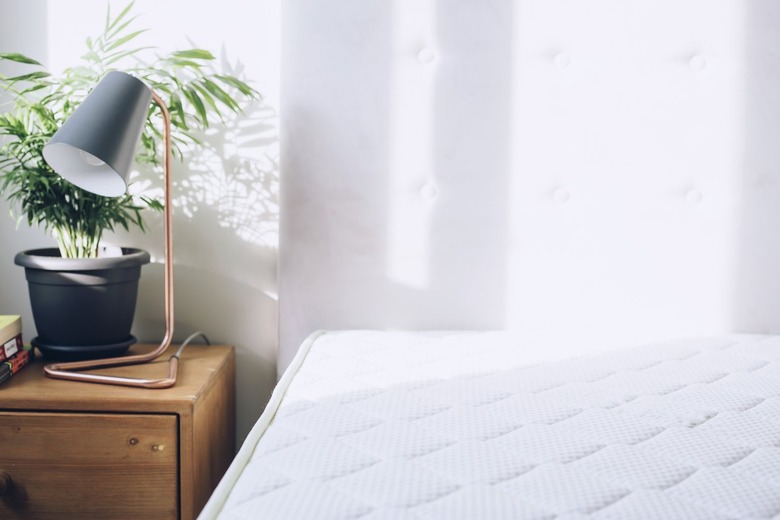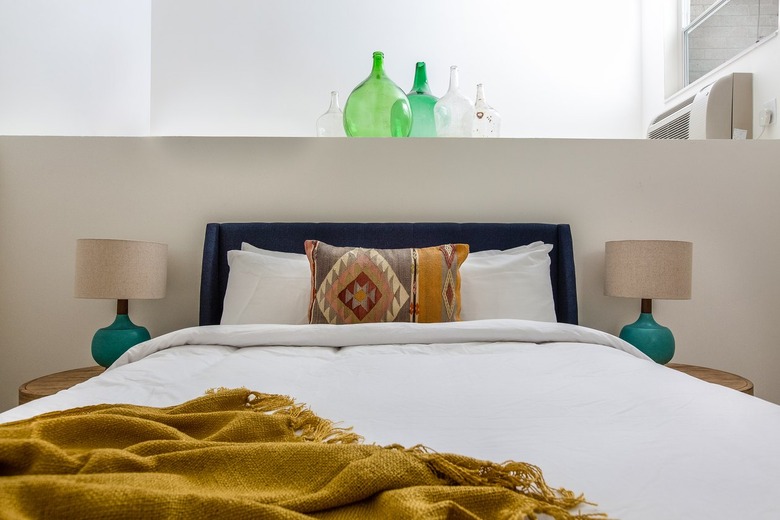There's Probably Fiberglass In Your Mattress. How Worried Should You Be?
We may receive a commission on purchases made from links.
If you've ever worked with fiberglass before, we don't have to tell you how itchy it can make you or what health problems it can cause. Knowing this, you would probably never sleep on a fiberglass mattress ... or would you? Mattress makers have been putting fiberglass in their mattresses for years, and a lot of consumers aren't aware of it. If you're looking for a new mattress (or suddenly looking at your mattress with skepticism in light of this new information), here is what you need to know about fiberglass mattresses and how they can negatively impact your health.
Why Is There Fiberglass in Mattresses?
Why Is There Fiberglass in Mattresses?
If fiberglass is potentially unsafe and uncomfortable, why do we put it in mattresses? To understand that, we must go back to the year 2007. In that year, the Consumer Product Safety Commission created the Standard for the Flammability (Open Flame) of Mattress Sets. This standard mandates specific rules about how long it takes a mattress to catch fire when exposed to a lit cigarette or other potential sources of ignition. Naturally, the longer it takes a mattress to catch fire, the better.
Fiberglass is both cost-effective and fire-resistant, making it relatively easy for mattress manufacturers to meet the new fire-resistance safety standards. When exposed to heat or fire, the fiberglass melts instead of catching fire. This helps to slow the spread of the fire and creates a melted barrier between the top of the mattress and the more flammable materials inside. This may not stop a roaring fire in every case but will certainly slow it down.
There was another good intention behind adding fiberglass to mattresses: It greatly reduced the need for fire-retardant chemicals. Instead of fiberglass, many manufacturers treated their mattresses with chemicals to make them more fire-resistant. Unfortunately, many of these treatments contained chemicals known as polybrominated diphenyl ethers (PBDEs). PBDEs are known to cause problems with both physical and mental development in children and started being phased out in 2004. Fiberglass seemed a viable alternative to dangerous chemicals.
Are Mattresses With Fiberglass Safe?
Are Mattresses With Fiberglass Safe?
Fiberglass mattresses land in the middle of the road when it comes to safety. The fiberglass is located inside the mattress and is generally safe as long as it stays there. If your mattress and mattress cover are in good condition, you probably don't have anything to worry about, but ripped or worn mattress covers can allow fiberglass fibers to escape the mattress, and this can be a problem.
Fiberglass is a skin irritant. If the fibers come into contact with your skin, it causes tiny cuts that are itchy and uncomfortable. Like all cuts, these can get infected and cause further problems. The glass fibers can also cause rashes and blisters. If the fiberglass particles get into the air, you can inhale them, which can make asthma worse and cause health issues, like bronchiolitis. Fiberglass fibers can also irritate the eyes and in some cases scar them.
Primary care physician Dr. Sabrina Barata of Maryland's Mercy Medical Center notes that people exposed to fiberglass may "experience symptoms of coughing or sneezing as your body naturally attempts to get rid of this material from your upper airway."
In addition to the health risks associated with mattresses containing fiberglass, the fiberglass particles released into the air can get into your HVAC system and spread themselves throughout your entire house. If so, removing them requires dusting surfaces with a damp cloth and vacuuming with a HEPA filter. You do not want to sweep, dry dust, or otherwise disturb settled fiberglass fibers and put them back into the air. In some cases, professional remediation is necessary to remove unwanted fiberglass particulates from your home.
How to Know If Your Mattress Contains Fiberglass
How to Know If Your Mattress Contains Fiberglass
If you've ever wondered why it's illegal to remove a mattress tag, this is your moment. The law forbidding tag removal is actually aimed at mattress makers and retailers. It requires that the tag stays on the mattress because it denotes what materials are found inside the mattress. If there is fiberglass in there, the tag will tell you.
It may not tell you directly, however. Some mattress manufacturers like to use words like "glass fibers, "silica," "glass wool," or "glass-reinforced plastic" rather than saying "fiberglass" directly. If it suggests glass or silica in any way, assume the mattress contains fiberglass. The words "Made in China" can also serve as a tipoff. Not every mattress made in China contains fiberglass, but international standards vary, and mattresses made outside the United States are more likely to contain fiberglass.
Mattress tags that warn you not to remove the mattress cover may also indicate the presence of fiberglass. The fiberglass is safe as long as it stays inside the mattress, but removing the mattress cover could expose the fiberglass and introduce it into the air.
Price can also be a clue. The cheaper the mattress, the more likely it is to contain fiberglass. A queen mattress selling for less than $600, for instance, likely contains fiberglass. Fiberglass is cheap, and using it allows mattress manufacturers to cut costs.
Buying a Mattress Without Fiberglass
Buying a Mattress Without Fiberglass
If the mere thought of fiberglass in your mattress is making you itchy, rest assured you can buy a fiberglass-free mattress. An easy way to do so is to shop for a specific type of mattress — namely, organic mattresses. These use wool and other natural materials to serve as flame retardants, making them the best mattress option for those who are worried about fiberglass.
If you're mattress shopping in person, checking for fiberglass is as easy as examining the mattress label. Online, you will need to read the mattress description carefully. If you're not sure whether fiberglass is present, email or call the mattress manufacturer and ask. Narrowing your search to products made in the U.S. can also help you avoid fiberglass.
It's also a good idea to do a web search for fiberglass mattress lawsuits before you go shopping and to check current mattress reviews. Mattress companies Zinus, Ashley Furniture, and Nectar are all facing class-action lawsuits regarding illness and property damage resulting from their fiberglass mattresses.
How Worried Should You Be?
How Worried Should You Be?
If you've just read your tag and learned that you're sleeping on a mattress made with fiberglass, don't panic — you likely haven't experienced any fiberglass exposure. If your mattress cover is free of rips, tears, holes, and thin spots, everything is fine. There is no reason to believe the fiberglass inside the mattress will find its way out of an intact mattress. If your fiberglass mattress is showing some signs of wear but replacing it just isn't in the budget, purchase an impermeable mattress protector. This will keep the fiberglass contained until you can replace the mattress with a fiberglass-free option.


